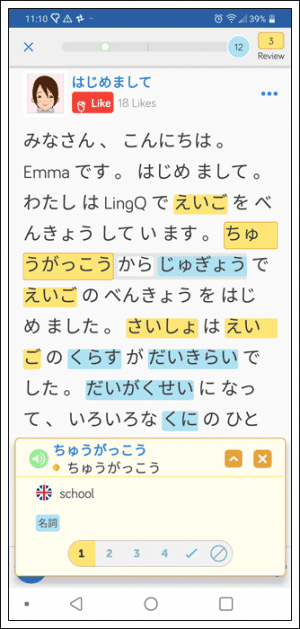Japanese Sentence Structure Explained
In English, there is a concrete grammatical structure. In a simple sentence, you have the subject, the verb, and the predicate.
Of course, this changes as we get into more complicated sentences, but there are concrete rules that serve as a mold for any sentence. In the English language, if a sentence is lacking an integral part, it is a sentence fragment, and incorrect grammatically.
Is Japanese sentence structure similar to English?
Japanese and English sentence structure are not at all similar. Many will say or teach that the structure of a Japanese sentence is a mixed-up version of the English sentence. Whereas English goes subject-verb-predicate:
Mary (subject) ate (verb) chocolate (predicate).
Japanese, they say, goes subject-predicate-verb:
ボブ (subject) はケーキ (object) を食べる(verb).
ボブ (bobu) would be the subject (Japanese version of Bob), ケーキ (ke-ki) the predicate or object (cake) and 食べる (taberu) would be the verb (eat).
While it is true that subject-object-verb is the more common way to frame a sentence, it is not the only way to do it. You could just as easily put the predicate first, like ケーキをボブは食べる (ke-ki [cake] (w)o bobu [Bob] wa taberu [eat]).
There are many other ways of structuring sentences in Japanese. You could even ignore many parts of the sentence and have a complete sentence, because Japanese does not have a set sentence structure. This may be surprising, but it is easy to get used to.
All you need to have a complete sentence in Japanese is a verb. For instance, 信じる (shinjiru [believe]) would be a complete sentence. It would be unusual for a sentence to be just a verb like this. Usually, a Japanese verb will be in a different form with its stem as a base, but that’s a different topic.
For now, let’s say it’s possible to have a verb in Japanese be a complete sentence. However, a sentence will usually have at least a subject. How do you mark a subject? This is done with particles. A particle will mark a word as a certain part of a sentence. These particles are what allow a Japanese sentence to not have any formal structure.
Using particles
In Japanese, a particle is placed at the end of the word to which it signifies grammatical meaning. Let’s go through a few of the more popular ones.
If I wanted the subject to be me, I could say 私は (watashi wa), which means I (私) am marked as the subject (は). The は is the particle. It is the kana (sort of like a letter in the Japanese alphabet) pronounced “ha” normally, but it is pronounced “wa” when used as a particle. If we take it with the earlier verb, and say 私は信じる (watashi wa shinjiru), then it would mean “I believe”. What I would be believing in would be made clear through context.
To understand what is being said in Japanese, it is often necessary to pick up on contextual clues. This may sound difficult coming from English, but it gets easier with time. For example, the phrase 私は信じる (watashi wa shinjiru [I believe]) above doesn’t necessarily have to be in the present tense. There are verb conjugations that show that something happened in the past or is currently happening, but no common conjugation to show that something is happening in the future. A sentence like this, without the verb being conjugated at all, is not limited in tense: it can be in the past, present, or future tense. Once again, which tense is being used should be made clear through context.
Identifying subjects
One way of identifying the subject is with the particle は (wa), but another particle that serves a similar purpose is が (ga). The differences between が and は are somewhat complicated, but for our purposes が also can identify the subject of a sentence. Another particle, を (wo), is effectively the same as が, but it has a more limited use in clauses with transitive verbs. So, one can say 私が行く (watashi ga iku) to say I (私) am (が) going (行く).
Though there is no set sentence structure in Japanese, a common one is to identify the subject with は and then what would in English be the predicate with が and then put the verb after it. For instance, 私はあの布団が欲しい (watashi wa ano futon ga hoshii [I want that futon]). In English, I (私) want (欲しい) that (あの) futon (布団). However, one could just as easily say あの布団が欲しい, 私は (ano futon ga hoshii, watashi wa [That futon want I]) or other such things, as there isn’t a fixed structure.
Of course, if the context makes it clear that the subject is yourself, then you can omit the subject altogether, and say something like あの布団が欲しい (ano futon ga hoshii [____ want that futon]). Alternatively, if what would be the predicate in English is clear through context (i.e., say you’re pointing to the futon you want), you can just say 私は欲しい (watashi wa hoshii [I want]). Or, if both the subject and what would be the predicate in English are clear enough through context, you can also just as easily say 欲しい (hoshii [want]). I hope this demonstrates how reliant upon context Japanese is while relating the lack of formal structure in the language.
How to use linking verbs
If I say “My name is Bob”, then the action is not clear. The verb “is” isn’t an action verb in this case, but a linking verb.
Similarly, you can say 私の名前はボブ (watashi no namae wa bobu), which means my (私の) name (名前) is (は) Bob (ボブ). The の particle is placed after a noun to denote that it is the possessor in a situation. So, “my” could be translated as 私の (watashi no).
What is important is that it would appear that the linking verb is the particle は (wa). While this is a perfectly acceptable sentence, it would be misleading to say that は is equal to “is”. For instance, the tense of my sentence in English is dependent upon the tense of the verb, in this case “is”. The same is true in Japanese. However, there is no way to change the particle は to indicate a different tense.
To do this in a sentence like this, we use a verb at the end, である (de aru). This denotes being. However, this isn’t really used in this way too much anymore, and you’d hear or read this a lot more often in works of fiction than in real life, as it is a fairly dated way of saying it. Instead, it is replaced with だ (da), or more formally です (desu).
To change the tense, you’d simply change the tense of these endings. So, for instance, the past tense of だ (da) is だった (datta), so if you wanted to say “My name was Bob”, then you could say 私の名前はボブだった (watashi no namae wa bobu datta [my name was Bob]). If you wanted to say this in a more polite manner, you could use the past form of です (desu), which is でした (deshita). 私の名前はボブでした (watashi no namae wa bobu deshita [my name was Bob]). The past tense of である is であった (de atta), for the curious. You put だ (da), です (desu), or less commonly である (de aru) in whatever tense is needed at the end of a sentence to denote the tense of the sentence. Knowing this, if one was so inclined, he could simply say ボブです (bobu desu [It is Bob]) to say that his name is Bob, provided that the context makes it clear that it is his name being talked about. Japanese is very context-heavy!
Adjectives in Japanese
In Japanese, there are two types of adjectives: -i adjectives and na adjectives. The first type ends in -i. While not all adjectives that end in -i are -i adjectives, all -i adjectives do end in -i.
Then you have na adjectives. These types of adjectives need you to put な (na) after them to establish they are adjectives. An example of an -i adjective is 辛い (karai), which means spicy. If you want to describe something as spicy, you simply put the adjective in front of the noun. 辛い焼きそば (karai yakisoba) would mean spicy yakisoba. An example of a な adjective would be 綺麗 (kirei, it is often spelled with kana instead of kanji, like きれい or キレイ, but the pronunciation stays the same). It means pretty. If I wanted to describe the ocean as pretty, I could say 綺麗な海 (kirei na umi), which means “pretty ocean”.
The adjective in Japanese should be placed before the noun. Similarly, any description in Japanese should be placed before the noun it describes. In English, we say “The man who ran here” as a way to describe the man. There is no equivalent “who” in Japanese. Instead, you’d say something like, ここに走った男 (koko ni hashitta otoko [the man who ran here]). ここ (koko) means here, に (ni) is a particle that indicates the location of a place, and 走った (hashitta) is the past tense of the verb 走る (hashiru), which means to run. This describes the man, or 男 (otoko). Similarly, all descriptions are used in a like manner, which helps create more complex sentences.
How to Ask Questions
So far, we’ve only looked at statements. But there is another type of English sentence that is fairly common: questions. How can we pose a question in Japanese? While there are question words in Japanese, they aren’t at all necessary to pose a question. You can simply say a normal statement except include a rising intonation. In writing, you can simply put a question mark. However, there is a much more solid way to indicate a question. In polite speech, to indicate a question, you simply add か (ka) to the end. For instance, 名前はボブですか? (namae wa bobu desu ka) would be “Is (your) name Bob?” in English.
However, in normal speech, do not ever expect to ask a question with the casual だ that was taught earlier. In such casual speech, putting the か at the end of a sentence often just implies doubt, and can sound sarcastic or rhetorical. Instead, you can simply use that inquisitive tone mentioned earlier or you could use that along with the character の at the end of a sentence. 名前はボブの? (namae wa bobu no) would be like “Is (your) name Bob?” in English. For a more action verb – like sentence, you could ask 行くの? (Iku no) to ask if someone is going somewhere (remember, context) in a casual way. The formal way to do that for this particular verb would be 行きます (ikimasu [go]), so one can simply ask 行きますか? (ikimasu ka [Going?]) to ask the same question in a polite manner.
This has been a very brief overlook of Japanese sentence structure. I hope that this will help all who are curious about Japanese grammar! For more general tips on learning Japanese, check out this post by polyglot Steve Kaufmann.
Learn Japanese Faster Using LingQ
Immersing yourself in Japanese doesn’t require you to travel abroad or sign up for an expensive language program.
However, it can be a bit tiresome to find interesting content, go back and forth between sites, use different dictionaries to look up words, and so on.
That’s why there’s LingQ. A language app that helps you discover and learn from content you love.
You can import videos, podcasts, and much more and turn them into interactive lessons. Its the best way to learn Japanese online!
Keep all your favorite Japanese content stored in one place, easily look up new words, save vocabulary, and review. Check out our guide to importing content into LingQ for more information.
LingQ is available for desktop as well as Android and iOS. Gain access to thousands of hours of audio and transcripts and begin your journey to fluency today.

***
Caiman Cotton is a freelance Japanese translator who has some experience in patent translation. He hopes one day to be fluent in (Ecclesiastical) Latin.


